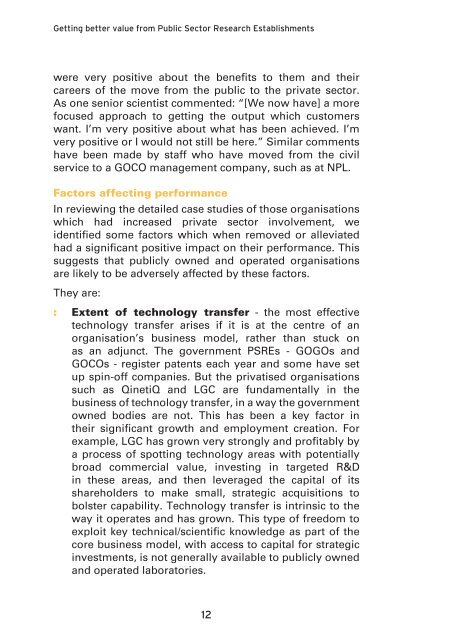Getting better value from public sector research ... - CentreForum
Getting better value from public sector research ... - CentreForum
Getting better value from public sector research ... - CentreForum
Create successful ePaper yourself
Turn your PDF publications into a flip-book with our unique Google optimized e-Paper software.
<strong>Getting</strong> <strong>better</strong> <strong>value</strong> <strong>from</strong> Public Sector Research Establishments<br />
were very positive about the benefits to them and their<br />
careers of the move <strong>from</strong> the <strong>public</strong> to the private <strong>sector</strong>.<br />
As one senior scientist commented: “[We now have] a more<br />
focused approach to getting the output which customers<br />
want. I’m very positive about what has been achieved. I’m<br />
very positive or I would not still be here.” Similar comments<br />
have been made by staff who have moved <strong>from</strong> the civil<br />
service to a GOCO management company, such as at NPL.<br />
Factors affecting performance<br />
In reviewing the detailed case studies of those organisations<br />
which had increased private <strong>sector</strong> involvement, we<br />
identified some factors which when removed or alleviated<br />
had a significant positive impact on their performance. This<br />
suggests that <strong>public</strong>ly owned and operated organisations<br />
are likely to be adversely affected by these factors.<br />
They are:<br />
:<br />
Extent of technology transfer - the most effective<br />
technology transfer arises if it is at the centre of an<br />
organisation’s business model, rather than stuck on<br />
as an adjunct. The government PSREs - GOGOs and<br />
GOCOs - register patents each year and some have set<br />
up spin-off companies. But the privatised organisations<br />
such as QinetiQ and LGC are fundamentally in the<br />
business of technology transfer, in a way the government<br />
owned bodies are not. This has been a key factor in<br />
their significant growth and employment creation. For<br />
example, LGC has grown very strongly and profitably by<br />
a process of spotting technology areas with potentially<br />
broad commercial <strong>value</strong>, investing in targeted R&D<br />
in these areas, and then leveraged the capital of its<br />
shareholders to make small, strategic acquisitions to<br />
bolster capability. Technology transfer is intrinsic to the<br />
way it operates and has grown. This type of freedom to<br />
exploit key technical/scientific knowledge as part of the<br />
core business model, with access to capital for strategic<br />
investments, is not generally available to <strong>public</strong>ly owned<br />
and operated laboratories.<br />
12





